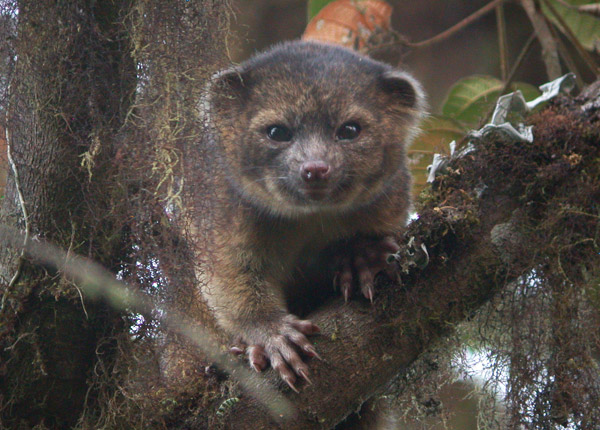While the olinguito looks like a wild, tree-climbing teddy bear with a cat’s tail, it’s actually the world’s newest mammalian carnivore. The remarkable discovery—the first mammal carnivore uncovered in the Western Hemisphere since the 1970s—was found in the lush cloud forests of the Andes, a biodiverse region home to a wide-range of species found no-where else. Dubbed the olinguito (Bassaricyon neblina), the new mammal is a member of a little-known, elusive group of mammals—olingos—that are related to raccoons, coatis, and kinkajous. However, according to its description in the journal Zookeys, the olinguito is the most distinct member of its group, separated from other olingos by 3-4 million years (or longer than Homo sapiens have walked the Earth).
“You can tell them apart by looking at almost any feature!” Kristopher Helgen, the lead scientist on the team and Director of Mammals at the Smithsonian Institute told mongabay.com. “Olinguitos are smaller than olingos, with longer, softer fur (shorter and harsher in olingos), they are more more colorful (usually reddish-brown or orange-brown in olinguitos, more brown, tan, or gray in olingos), and they have a shorter, bushier tail, smaller ears, and a more rounded face. Olinguitos have larger molars, smaller bones of the ear, and somewhat differently shaped skulls compared to olingos.”

The world’s newest species in the mammal order Carnivora: the olinguito. The one was photographed in the wild at Tandayapa Bird Lodge, Ecuador. Photo by: Mark Gurney.
Olinguitos are also the only one in the family that inhabit high-altitude cloud forests at 5,000 to 9,000 feet above sea level.
It’s not that scientists were wholly unaware of the animal, but simply that for over a century they mixed it up with species of lowland olingos. In fact, the olinguito was even housed at U.S. zoos in the past, but was identified as an olingo. It’s smaller body, distinct shape, and high-altitude habitat was simply not recognized.
Helgen and his research team first noticed distinct differences between the olinguito and its relatives in museum specimens. This discovery led Helgen to try and find living animal in the wild—if they still existed. A video captured by an Ecuadorean zoologist, Miguel Pinto, of a wild olinguito, proved a breakthrough. And soon Helgen, along with Roland Kays, with the North Carolina Museum of Natural Sciences, were on their way to Ecuador.
Related articles
Photos: new mammal menagerie uncovered in remote Peruvian cloud forest

(10/03/2012) Every year scientists describe around 18,000 new species, but mammals make up less than half a percent of those. Yet mammal surprises remain: deep in the remote Peruvian Andes, scientists have made an incredible discovery: a rich cloud forest and alpine grassland ecosystem that may be home to no less than eight new mammal species. Although most of these new mammals are currently under study—and have not been officially described yet (a process which can take several years)—lead scientists, Horacio Zeballos of Peru and Gerardo Ceballos of Mexico are certain they have uncovered a small forest, surrounded by deforestation and farmland, that shelters a remarkable menagerie of mammals unknown to scientists until now.
Pictures: Bolivian park may have the world’s highest biodiversity

(09/12/2012) With over 90 species of bat, 50 species of snake, 300 fish, 12,000 plants, and 11 percent of the world’s bird species, Madidi National Park in Bolivia may be the world’s most biodiverse place, according to new surveys by the the Bolivian Park Service (SERNAP) with aid from the Wildlife Conservation Society (WCS).